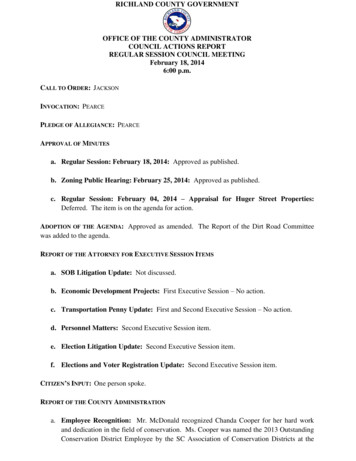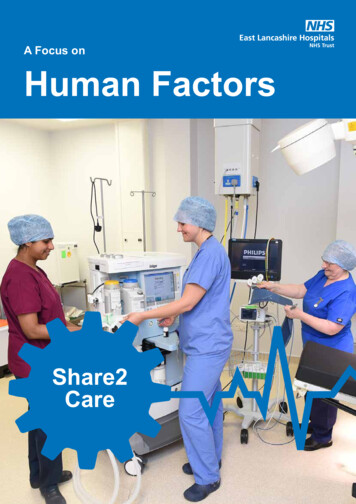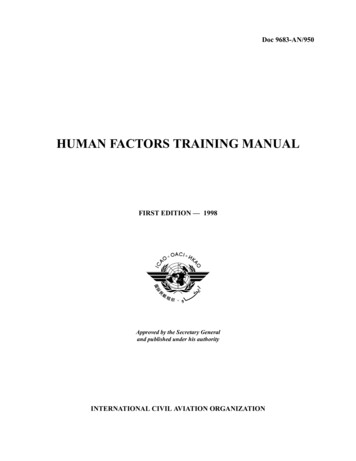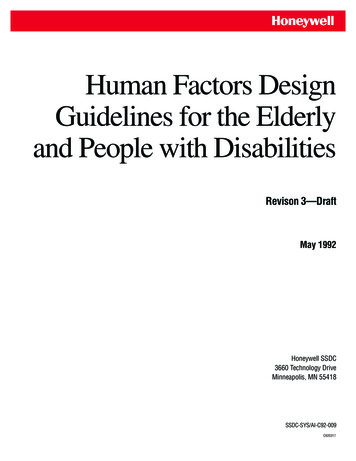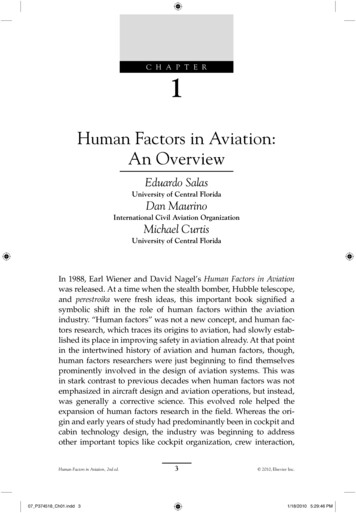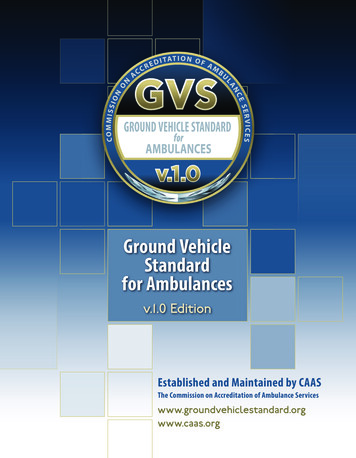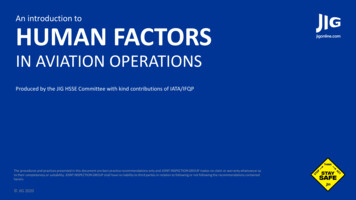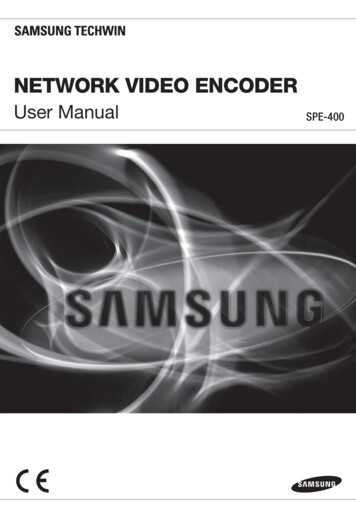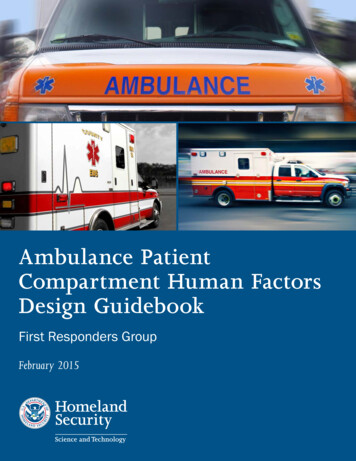
Transcription
Ambulance PatientCompartment Human FactorsDesign GuidebookFirst Responders GroupFebruary 2015
Ambulance Patient Compartment Human FactorsDesign GuidebookJanuary 13, 2015Prepared for:U.S. Department of Homeland SecurityScience and Technology DirectorateFirst Responders GroupContract No: GS-10-F-0181J Order No: HSHQDC-11-F-00054In partnership with:National Institute of Standards and Technology100 Bureau Dr.Gaithersburg, MD 20899Jennifer MarshallAllison Barnard FeeneyY. Tina LeeDeogratias KibiraPrepared by:Larry AveryAllie JacobsJennifer MooreCarlotta BooneBMT Designers & Planners2120 Washington Blvd.Suite 200Arlington, VA 22204(703) 920-7070Tom MaloneCarlow International20856 Waterbeach Pl.Potomac Falls, VA 20165(703) 444-4666
ForewordAmbulance crashes are one of many hazards faced by emergency medical servicesproviders (EMSP). Data from the National Highway and Traffic Safety Administrationindicates EMSP experience a fatality rate three times the average national occupationalinjury rate and cite ambulance crashes and related vehicle accidents as one of the threatsfacing EMSP. Studies also found EMSP and patient deaths or serious injuries occurred at ahigh rate within the patient compartment of the ambulance during transport. These incidentswere often related to EMSP not using restraint systems, such as seatbelts, improperlyrestrained patients and equipment, unpadded or intrusive equipment that could causeserious head-impact injuries, and structural design deficiencies in the vehicle itself.EMSP, the Federal Interagency Board and national emergency medical services (EMS)associations expressed the need for safer ambulance design standards to the U.S.Department of Homeland Security (DHS) Science and Technology Directorate (S&T) FirstResponders Group (FRG). The FRG has brought together members of the private sector,EMS leaders and research and development partners. This group aims to design anddevelop safety standards, produce crash standards and design recommendations that willlead to the next generation ambulance compartment and ultimately a safer work and patientcare environment.This Ambulance Patient Compartment Human Factors Design Guidebook (the Guidebook)has been developed as a best practices guide to help augment that safer work and patientcare environment. It is a result of more than four years of research and development,testing, modeling and simulation, human performance measurements, assessment andinteraction with the EMS community, ambulance manufacturers and component providers.This Guidebook provides examples and recommendations for the steps to take whendesigning an ambulance patient compartment and best practices that can help reduceEMSP and patient injuries. This document will also help streamline the compartment layoutand make it more conducive to providing patient care. The Guidebook has been developedto be beneficial to EMS leaders, EMSP, ambulance specification committees andmanufacturers. The Guidebook is not intended to provide solutions or a standard design, butto establish a framework for the EMS community to implement a higher level of safety andpatient care quality. The Guidebook is built upon an analysis of current standards andrecommendations and will help EMSP through a needs-centered process that leads to anext-generation ambulance interior focused on safety, effectiveness and efficiency.The Guidebook is part of a larger program funded and developed by the FRG that isconcentrated on reducing risks associated with ambulance crashes and the safetyassessment of ambulance components, to include all aspects of the patient compartmentincluding seats, personnel and equipment restraints, storage cabinets, patient cots, andfastening mechanisms. Recommendations from this program will also be found in the 2016Edition of the National Fire Protection Association (NFPA) 1917 Standard for Automotiveii
Ambulances (expected for release in early 2016) and in seven international standardsadopted by the Society of Automotive Engineers (SAE).Some of the recommendations contained in the Guidebook represent possibilities for futuredesign and may present challenges for near term implementation. The Guidebook serves tostimulate discussion regarding what equipment and practices are necessary in the patientcompartment and may spur changes in all forms of EMSP and patient safety for the EMScommunity. While this body of research has helped to develop recommendations and safercomponents for the ambulance patient compartment, it is not meant to be considered asolution to eliminating injuries and death for patients and EMSP.iii
Executive SummaryThe Ambulance Patient Compartment Human Factors Design Guidebook, hereafter referredto as the Guidebook, is the result of a multiyear effort on the part of the U.S. Department ofHomeland Security (DHS) Science and Technology Directorate (S&T) First RespondersGroup (FRG). It is intended to provide tools and guidance to the Emergency MedicalServices (EMS) community that will enable the design and manufacture of ambulancepatient compartments that are safer and more efficient. The FRG received support in thedevelopment of the Guidebook through collaboration between the National Institute ofStandards and Technology (NIST), the National Institute for Occupational Safety and Health(NIOSH), BMT Designers and Planners (D&P), and Carlow International as well as inputfrom members of the EMS community representing both EMS providers (EMSP) andmanufacturers.EMSP routinely perform essential medical care as they stabilize patients at emergencyscenes and provide treatment en route to medical facilities. High injury and fatality ratesamong EMSP (Maguire, 2002; Green et al., 2008; Reichard et al., 2011; Maguire, 2013)underscore the need for safer and more resilient ambulance design and construction, moreefficient patient compartment layouts that allow EMSP to be seated and restrained whiletending to patients, and ergonomically designed work spaces that keep EMSP and theirpatients safe and comfortable and EMSP productive while performing their tasks.Consistent analytics regarding ambulance standards will ensure EMSP and patient safetywhile enhancing EMSP patient care. Although standards such as the National FireProtection Association (NFPA) 1917 Standard for Automotive Ambulances, 2013 Editionand the General Services Administration (GSA) KKK-A-1822F Federal Specification for theStar of Life Ambulance outline the requirements for mobile emergency medical servicevehicles, they do not provide in-depth design criteria and best practices that address EMSPsafety, health and performance. To augment these requirements, FRG in partnership withNIST, NIOSH, D&P and Carlow International launched a study to develop standards,guidelines and best practices for ambulance patient compartments. This research focuseson addressing resiliency in a vehicle accident, patient safety and comfort, and EMSP safety,health and performance.NIOSH is currently characterizing injury risks associated with ambulances crashes. They arealso assessing the durability of components in patient compartments, including seats,restraints, cabinets and fastening mechanisms, and drafting specifications that will guide thedesign and selection of safer patient compartment components. These specifications havebeen proposed for inclusion in the 2016 Edition of NFPA 1917 Standard for AutomotiveAmbulances and published as Society of Automotive Engineers (SAE) Internationalstandards.Under the guidance of the FRG and NIST, D&P and Carlow International conducted amultiyear user-centered design (UCD) process that developed and refined ambulanceiv
patient compartment design requirements and guidelines by actively engaging EMSP andmanufacturers (Avery et al., 2013; Feeney et al., 2012; Moore et al., 2011; Moore et al.,2012; Dadfarina et al., 2012; Lee et al., 2013; Kibira et al., 2012). This effort began withEMSP soliciting the help of the FRG with the objective of centralizing and eventuallystandardizing a best practices approach to ambulance safety. By sharing user research, theFRG was provided a more detailed understanding of the nature of EMS work and anawareness of EMSP needs gathered through observations and discussions with users,focus groups and surveys. From this list of needs, design requirements and guidelines weredeveloped and iteratively refined and confirmed through EMSP reviews. The requirementsand guidelines were further validated through the development of designs as a proof-ofconcept of the application of the design guidelines. Based on reviews by EMSP,manufacturers, and other EMS community representatives, the design concepts,requirements and guidelines were updated and finalized.This process has resulted in a comprehensive list of design guidelines and best practices forambulance patient compartments that fulfill the needs and requirements of a wide range ofEMS provider organizations (EMSPO). Of these requirements and guidelines, those thatwere suitable for standardization were proposed for inclusion in the upcoming version ofNFPA 1917.The Guidebook documents a UCD and evaluation process tailored for ambulance patientcompartment design and a full list of requirements and guidelines. This Guidebook isintended to serve as a tool to enable EMSPO and manufacturers to design and specifyfuture ambulance patient compartments based on its unique user needs that maximizeEMSP performance and ensures the safety and health of the EMSP and patients.The Guidebook addresses the following topics associated with patient compartment design: Human factors engineering; User-centered design; Seating and restraints; Equipment and supplies; Storage; Workspace; Ingress and egress; Communication; and Type II ambulances (A Type II ambulance is based on a standard van chassis andtypically has a much smaller integral patient compartment).v
AcknowledgementsIn addition to expressing our appreciation to members of DHS S&T FRG for providingreview, comments and key insights, the authors would like to thank the EMS community fortheir invaluable support in developing this Guidebook. We are grateful for contributions from: Manufacturers who provided information, participated in focus groups andworkshops, and provided comments on drafts of the Guidebook. EMSPO that opened their doors to our team members to allow unrestricted access totheir personnel and equipment. EMSP who gave their time to participate in interviews, focus groups, workshops andan online survey, and reviewed different versions of the Guidebook to providecomments. Conference organizers for EMS Today and EMS World Expo for providing space formeetings such as workshops and focus groups and booths on the exhibit floors. National Association of Emergency Management Technicians who published anumber of articles in their newsletters to keep the EMS community informed ofprogress.vi
Table of ContentsForeword. iiExecutive Summary . ivAcknowledgements . vi1.0 Introduction . 11.1 Purpose and Scope . 21.2 Intended Audience. 21.3 How to Use the Guidebook . 22.0 Human Factors Engineering in Patient Compartment Design . 42.1 General Human Factors Engineering (HFE) Principles Applied to Ambulance Design . 42.2 Human Factors Engineering in Patient Compartment Design . 52.2.1 Objectives of HFE for Patient Compartment Design . 52.2.2 HFE Design Goals in Patient Compartment Design . 53.0 User-Centered Design and Evaluation . 73.1 User-Centered Design Process . 73.1.1 Design Plan. 83.1.2 Phase 1-Requirements Development . 93.1.3 Phase 2-Concept Development and Evaluation .133.1.4 Phase 3-Design Specification Development .183.1.5 Phase 4-Build .193.1.6 Phase 4-Deployment .193.2 Tailoring of the UCD Process .193.3 User-Centered Evaluation of Existing Designs .203.3.1 Design Inspection.203.3.2 Table Top Walkthrough .213.3.3 Human Modeling and Simulation .213.3.4 Real-time Task Walkthroughs .223.4 System-Level Design .224.0 Seating and Restraints .244.1 Reach to Patient .244.1.1 Minimum Patient Care Reach.244.1.2 Optimum Patient Care Reach.254.2 Facing the Patient.254.3 Performing Cardiopulmonary Resuscitation While Restrained .264.4 Accessing Equipment .264.5 Ergonomic Design .274.5.1 Seating .274.5.2 Restraint Systems .28vii
4.6 Equip Each Work Position with Restraints .294.7 Ensure Quick Donning and Doffing of Restraints .294.8 Design Seating for Safety .294.9 Transport of Children .304.10 Transport of Additional Passengers .315.0Equipment and Supplies .325.1Patient Transport and Loading .335.1.1Cot Loading .335.1.2Cot Loading Mechanisms .335.1.3Cot Guidance and Securing .345.1.4Cot Restraints .355.1.5Cot Equipment Storage.365.1.6Powered Cot .375.1.7Cot Height.375.1.8Backboard .375.2Equipment Accessibility While Seated and Restrained .385.3Labeling and Text Displays .395.4First-In Kits.415.5Reduced Injury Risk .42Automated CPR Devices e Storage Space Available .45Accessibility While Standing .45Accessibility While Seated and Restrained .46Storage Cabinet Doors and/or Drawers .47Consistency and Organization .47Reduced Injury Risk .48Labeling and Identification .50Secure Personal Belonging Storage .50Workspace .527.1Comfortable and Appropriate Working Environment .527.1.1Heating, Ventilation, and Air Conditioning (HVAC) .537.1.2Lighting .547.1.3Noise .557.1.4Power .557.2Equipment Accessibility While Seated and Restrained .557.2.1IV Bag Accessibility.557.2.2Oxygen (O2) and Suction Port Accessibility.567.2.3Equipment, Supply and Control Operation and Access .567.3Consistency and Organization .577.4Maintainability .587.5Interior Structure and Layout .58viii
Trash and Sharps Disposal .60Second Patient Transport .617.67.78.0Ingress and Egress .628.1Ingress and Egress in Normal and Adverse Weather Conditions .638.1.1 Doors .638.1.2 Steps.648.1.3 Handholds and Handrails .658.1.4 Windows .658.2Emergency Egress.659.0Communication .679.19.29.39.4Easily Understood Communication between EMSP, Driver and Third Parties .68Accessibility to Communication Devices .69Facilitation of Effective Patient Care by Communication Devices .69Notifications from the Driver Compartment .7010.0 Type II Ambulance Patient Compartment Design Considerations .7110.1 Applicability of the Guidebook to Type II .72Definitions and Acronyms .73Definitions .73Acronyms .77References .79Appendix A-Ambulance Patient Compartment Anthropometric Data . A-1Appendix B-Applicable Standards and Documents . B-1FiguresFigure 1. Basic User-Centered Design Process . 7Figure 2. Process for Development and Evaluation of Concepts .14Figure 3. Illustration of Initial Design Concepts.15Figure 4. Illustration of a More Detailed Design Concept .15Figure 5. Illustration of a Jack Model for Assessing Reach in a Design Concept .17Figure 6. Illustration of a Final Design Concept .18Figure 7. Illustration of a Design Checklist .21Figure 8. Illustration of Minimum Patient Reach .25Figure 9. Illustration of Maximum Functional Reach for 5th Percentile Female.27Figure 10. Diagram of Elements of an Ergonomic Seat .28Figure 11. Orientation of Patient Compartment Displays .38ix
Figure 12. Character Width .40Figure 13. Character Stroke Width .40Figure 14. Illustration of 5th Percentile Female’s Functional Reach while Standing .46Figure 15. Maximum Lift Heights .49Figure 16. Maximum Twisting Motion .49Figure 17. Hand Clearance .50Figure 18. Workstation Overhang Clearance for EMSP Knees .59Figure 19. Step Height and Tread Depth .64Figure 20. Maximum Functional Reach for a 5th Percentile Female.75Figure 21. Adult Standing and Sitting Body Dimensions. A-1Figure 22. Adult Hand Measurements . A-3TablesTable 1. Potential UCD Team Members . 8Table 2. Definiton of User Design Need, Requirement and Guidelines . 9Table 3. Example of a Patient Compartment User Design Need, Requirements and Guidelines.10Table 4. UCD Methods.11Table 5. Character Height of Labeling .39Table 6. Intelligibility Guideline for Voice Communication Systems .68Table 7. Adult Anthropometric Measurements Used in the Guidebook . A-2Table 8. Adult Hand Anthropometric Measurements Used in the Guidebook . A-3Table 9. Child Anthropometric Data Used in the Guidebook. A-4Table 10. Standards and Documents Relevant to the Design of an Ambulance PatientCompartment . B-1x
1.0 Introduction1.0 IntroductionThe Ambulance Patient Compartment Human Factors Design Guidebook, hereafter referredto as the Guidebook, is the result of a multiyear effort on the part of the U.S. Department ofHomeland Security (DHS) Science and Technology Directorate (S&T) First RespondersGroup (FRG). It is intended to provide tools and guidance to the Emergency MedicalServices (EMS) community that will enable the design and manufacture of ambulancepatient compartments that are safer and more efficient.EMS providers (EMSP) face high injury and fatality rates due to the nature of their work,providing critical patient care in rapidly moving ambulances, as has been cited in numerouspublications (Maguire, 2002; Green et al., 2008; Reichard et al., 2011). They alsoexperience high levels of musculoskeletal injuries due to lifting of patients or otherequipment (Maguire, 2013). Much of this risk can be attributed to the design and layout ofpatient compartments, which are typically not designed to allow EMSP to perform theirpatient care tasks while remaining seated and restrained.These vehicle accidents involving ambulances have a significant financial impact on theEMS community. Costs associated with an accident may include medical expenses, lostwork time, disability expenses, legal fees, equipment repair and replacement expenses,workman’s compensation, recruitment and training costs for employee replacement andincreased insurance costs. Motor vehicle crashes cost employers 60 billion annually inmedical care, legal expenses, property damage and lost productivity (McGowan 2012). Theaverage crash costs an employer 17,500. When a worker has an on-the-job crash thatresults in an injury, the cost to their employer is 74,000. Costs can exceed 500,000 whena fatality is involved.Designing and manufacturing safer and more efficient patient compartments can befacilitated through the implementation of a user-centered design (UCD) process. The UCDprocess integrates safety, ergonomics and human factors principles and best practices, aswell as an understanding of how EMSP perform their job, into the design and manufacturingof an ambulance. The goals of applying this design process are to:a. Ensure EMSP needs (e.g., provide safe and effective patient care) and all practical andfunctional requirements (e.g., ability to reach a patient’s body from head to knee from aseated and restrained position) are identified early in the process.b. Engage EMSP and other subject matter experts throughout the ambulance patientcompartment design and build a process to provide feedback on whether the design isfunctional, usable, safe and meets the needs and requirements that were identified.c. Provide a final design that will optimize not only EMSP performance and safety, but alsooverall ambulance design effectiv
Jan 13, 2015 · The Ambulance Patient Compartment Human Factors Design Guidebook, hereafter referred to as the Guidebook, is the result of a multiyear effort on the part of the U.S. Department of Homeland Security (DHS) Science and Technology Directorate (S&T) First Responders Group (FRG). It is intend
